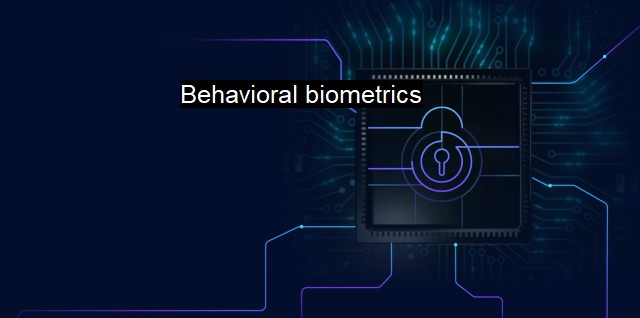What are Behavioral biometrics?
Enhancing Cybersecurity: Leveraging the Promising Concept of Behavioral Biometrics
Behavioral Biometrics is a technology associated with cybersecurity that creates a personalized, dynamic signature of an individual. The principle of behavioral biometrics is to create a model that recognizes the unique physical and behavioral traits of an individual that cannot be easily replicated. Various characteristics such as typing style or patterns, mouse movement, voice, the way one holds a smartphone—among many others, are utilized in this process. Compared to traditional forms of security, such as passwords or physical biometrics like fingerprints, behavioral biometrics examines an ongoing expression of human behavior which makes it a powerful tool for distinctive identification and authentication thereby offering vast potential for applications antivirus, and privacy protection.The role of Behavioral Biometrics in cybersecurity stems from its ability to monitor, document, and analyze human activities in real time to authenticate or deny credentials. This is instrumental in detecting and acting against suspicious or deviant behavior that could indicate a potential security threat. One of the key advantages of behavioral biometrics is that unlike static biometrics, where once compromised, cannot be reinstated, you can always modify behavioral patterns thus adding another layer to the defense mechanism against cyber threats.
The algorithm of behavioral biometrics employs two components: identification and verification. The former identifies the traits unique to an individual through continuous data collection and analysis while the latter uses these to authenticate an individual against the identified traits recorded in the system. This two-tier system can identify the anomalies promptly.
In the antivirus context, behavioral biometrics can be utilized to determine whether the actions being undertaken by a user are human or automated (bots). Regular user behavior like browsing, clicking on webpages, or typing can be recognized and distinguished from suspicious behaviors such as automated rapid inputs or repeated actions linked with malware or viruses. This is instrumental in distinguishing potential threats from regular activities, and without the need of any personal data, this technology ensures the privacy protection of the user.
For instance, online banking or e-commerce—one of the crucial areas where security breaches regularly post costly cyber threats. Adoption of behavioral biometrics ensures a secure platform due to its ability to track and analyze various details like the way a customer types, the pressure they put on their touch screen, the speed they scroll—these signals can be used to differentiate regular user behavior from that of a cyberattacker. If the system detects inconsistencies or alterations to the regular pattern, it raises a concern and the potential threat can be easily dealt with.
There is another side to this technology that has sparked some concern. There are some potential issues regarding privacy as continuous surveillance and tracking might be conceived as intrusive. there's always an element of uncertainty as it is impossible to achieve perfect correlation between an individual's behavior and their biometric profile.
Even though the improper use of this technology may give rise to practical and ethical issues, the advantages associated with it make it an emerging technology in the field of cybersecurity. Compared to other forms of security, the dynamic and continuous nature of behavioral biometrics makes it hard for cybercriminals to predict or falsify. With further development and responsible applications, we can only expect behavioral biometrics to play an increasingly significant role in availing secure digital spaces.
Behavioral Biometrics, powered by machine learning and advanced algorithms, is an innovative and sought-after mechanism in cybersecurity protection and antivirus measures. By correlating unique behavioral patterns with those recorded in a data system, it provides robust protection while assuring user authenticity. the technology must be ethically applied and further democratize and ensure privacy concerns are consistently taken into account.

Behavioral biometrics FAQs
What is behavioral biometrics?
Behavioral biometrics is a type of cybersecurity measure that uses unique human behaviors to identify individuals. It involves analyzing patterns in the way we interact with technology, such as how we type on a keyboard, move a mouse or swipe a touchscreen.How does behavioral biometrics enhance antivirus protection?
Behavioral biometrics enhances antivirus protection by adding an extra layer of security. Traditional antivirus software often relies on detecting known viruses and malware to block attacks. Behavioral biometrics, on the other hand, can identify suspicious behavior that may indicate a new, previously unknown threat.Is behavioral biometrics reliable?
Behavioral biometrics can be very reliable. Every individual has unique behavioral patterns, so it can be difficult for attackers to mimic them convincingly enough to bypass this type of security. However, like any security measure, it is not foolproof and can be circumvented with sophisticated attacks.What are some examples of behavioral biometrics?
Examples of behavioral biometrics include keystroke dynamics, mouse movement analysis, and touch dynamics on smartphones and tablets. Other examples include gait analysis, voice recognition, and facial recognition. These technologies compile data on how users perform certain tasks, such as typing, and use that data to create a unique profile for each user.| | A | | | B | | | C | | | D | | | E | | | F | | | G | | | H | | | I | | | J | | | K | | | L | | | M | |
| | N | | | O | | | P | | | Q | | | R | | | S | | | T | | | U | | | V | | | W | | | X | | | Y | | | Z | |
| | 1 | | | 2 | | | 3 | | | 4 | | | 7 | | | 8 | | |||||||